InterCity (Iarnród Éireann)
InterCity (Irish: IdirCity) is the brand name given to rail services operated by Iarnród Éireann that run between Dublin and other major cities in Ireland. InterCity branding is also used in other European countries by unaffiliated organizations.
| InterCity | |
|---|---|
 | |
 | |
| Overview | |
| Type | InterCity |
| System | Iarnród Éireann |
| Status | Operational |
| Locale | Ireland |
| Stations | 83 |
| Services | 14 |
| Operation | |
| Opened | 1972 (As Mainline) 1984 (As InterCity) |
| Owner | Iarnród Éireann |
| Operator(s) | Iarnród Éireann |
| Rolling stock | 201 Class Mark 4 22000 Class |
| Technical | |
| Number of tracks | 2-6 |
| Track gauge | 1,600 mm (5 ft 3 in) |
| Operating speed | 160 km/h (99 mph) maximum |
Services
InterCity services from Dublin operate from two main stations:
- Heuston - Heuston Station is the terminus for services to the south and west of Ireland. Services from Heuston operate to Cork, Galway, Waterford, Tralee, Westport and Limerick.
- Dublin Connolly - Connolly Station is the terminus for services to the east and north-west of Ireland. Services from Connolly operate to Sligo and Rosslare Europort. Dublin Connolly is also the terminus of the Dublin to Belfast main line, with services to Belfast Central provided by Enterprise.
Although Dublin is the hub of InterCity services with all "radial routes" terminating there, there are other services which may be considered as InterCity including;
- Cork-Tralee
- Limerick-Galway
- Waterford-Limerick
Rolling stock
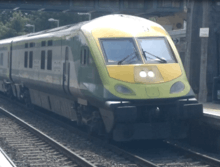
InterCity services are operated using a mixture of locomotive pulled coaching stock and DMUs. In 2006, deliveries began of 67 new Mark 4 coaches, specifically for the flagship Dublin-Cork route, in an order costing approximately €117 million. These are formed into 8 carriage trains, pulled by a 201 class locomotive, and operate an hourly service between Cork and Dublin. The entry into service of the Mark 4 stock allowed the Mark 3 coaching stock to be cascaded to other routes, allowing in turn the withdrawal of the elderly "Cravens" and Mark 2 coaches. In 2007, the first of a total 183 coaches of the new 22000 Class diesel multiple unit were delivered, of which 150 vehicles are for InterCity services, the remaining for use on Commuter routes, at a total cost of approximately €400 million. These trains, which are in 3-car, 4-car and 5-car formations, replaced the Mark 3 coaches formerly in use on the routes between Dublin and Limerick, Galway and Waterford and the 2800 Class and 29000 Class DMUs on the Dublin to Sligo and Dublin to Rosslare Europort services, and on the services that do not terminate in Dublin. The Commuter DMU rolling stock was then transferred to the expanded Commuter services from 2008 until 2012, when all 22000 Class DMUs had entered service. The first 22000 Class train entered service on 18 December 2007 on the service to Sligo.[1] These DMUs now operate all Dublin-Sligo, Dublin-Tralee and Dublin-Limerick services, as well as all Dublin-Westport services and Dublin-Galway, Dublin-Waterford and Mallow/Cork-Tralee services. The final deliveries of the 22000 Class took place in 2012. As of 2016 all InterCity and many Commuter routes are operated with 22000 Class units, with the exclusion of most Cork-Dublin and Belfast-Dublin services.
Current Fleet
| Class | Image | Type | Top speed | Number | Routes operated | Built | |
|---|---|---|---|---|---|---|---|
| mph | km/h | ||||||
| 201 Class | Diesel locomotive | 100 | 160 | 32 | Dublin-Cork, Dublin-Belfast | 1994–1995 | |
| 22000 Class | 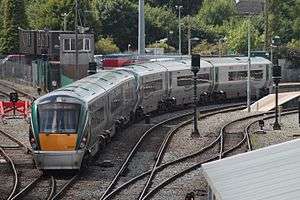 |
Diesel multiple unit | 100 | 160 | 28 3-car, 25 4-car & 10 5-car sets | Cork-Tralee, Dublin-Belfast (Occasionally), Cork, Galway, Limerick, Rosslare, Sligo, Waterford, Westport | 2007–2011 |
| Mark 4 | Passenger coaches | 125 | 200 | 67 | Dublin-Cork. | 2004-2005 | |
| Driving Van Trailer (DVT) | |||||||
Commuter stock
In addition to the dedicated InterCity rolling stock, a number of Commuter branded DMUs are used on rural routes that are classed as InterCity by Iarnród Éireann.
| Class | Image | Type | Top speed | Number | Routes operated | Built | |
|---|---|---|---|---|---|---|---|
| mph | km/h | ||||||
| 2600 Class | 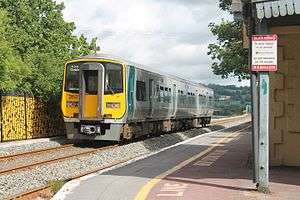 |
Diesel multiple unit | 70 | 110 | 8 | Cork Commuter Routes | 1993 |
| 2800 Class | 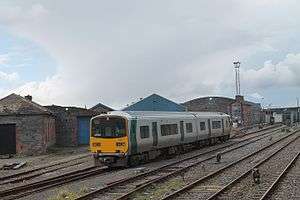 |
Diesel multiple unit | 75 | 120 | 8 | Cork & Limerick Commuter Routes | 2000 |
| 29000 Class | 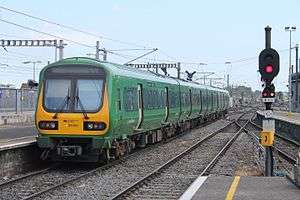 |
Diesel multiple unit | 75 | 120 | 29 | Dublin-Rosslare, Dublin Commuter | 2002 - 2005 |
Past Fleet
| Class | Image | Type | Top speed | Number | Routes operated | Built | Withdrawn | Notes | |
|---|---|---|---|---|---|---|---|---|---|
| mph | km/h | ||||||||
| 121 Class | 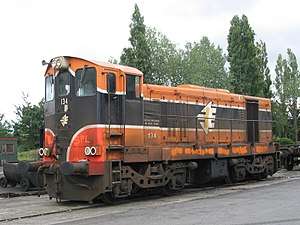 |
Diesel locomotive | 77 | 124 | 15 | Dublin-Galway Dublin-Sligo Dublin-Waterford |
1960-1961 | 1995-2008 | |
| Mark 2 | Passenger coaches | 100 | 161 | 15 | All routes | 1972-1989 | 2004-2008 | Based on the British Rail Mark 2 | |
| Mark 3 | Passenger coaches | 125 | 200 | 133 | All routes | 1980-1989 | 2006-2009 | Based on the British Rail Mark 3 | |
| 181 Class |  |
Diesel locomotive | 75 | 120 | 12 | All routes | 1966 | 1991-2009 | |
| 141 Class | Diesel locomotive | 76 | 123 | 37 | All routes | 1962 | 2010-2011 | 5 stored at Inchicore works. | |
| 071 Class |  |
Diesel locomotive | 90 | 145 | 18 | All routes | 1976 | 2010-2011 | Still in use on mixed traffic services; also used on railtours. |
Future
Western Rail corridor
The Department of Transport's project proposed that several hundred million euros would be invested by the Irish Government in improving the railway network. This would see connection of some of the radial lines out of Dublin, which enable inter-regional services to be operated without travelling through the capital. A major part of this included plans for the reinstatement of the Western Rail Corridor between Ennis and Claremorris, a route totalling 110 km/68.5 miles.
- Stage 1 - Ennis to Athenry - Completed
- Stage 2 - Athenry to Tuam - Deferred indefinitely
- Stage 3 - Tuam to Claremorris - Deferred indefinitely
If stages 2 and 3 were completed, the Westport, Galway and Limerick lines from Dublin would be connected, allowing regional InterCity services to be run between these destinations without having to travel via Dublin.
Stage 1 of the project began on 16 November 2007, relaying track between Ennis and Athenry, a distance of approximately 60 km/36 miles.[2]
The WRC project has been widely criticised as passenger numbers have been extremely low, with critics saying it would be cheaper for Irish Rail to put each passenger in a taxi than running the train. Rhetoric aside the line has seen massive growth as reported in the Irish Times: "Of particular note was the growth in passenger numbers on the western rail corridor, which saw a 72.5 per cent increase from 29,000 to 50,000 journeys through the Ennis- Athenry section of the line."[3] Almost 100,000 people used the service between Ennis and Galway in 2017. 390,000 travelled on the line between limerick and Galway in 2018. Passenger numbers are up 22.9% in the first quarter of 2019 and the line is expected to carry 420,000 people this year
Dublin-Cork
Iarnród Éireann also maintains an ambition to increase speeds on the Dublin-Cork line. The current Mark 4 coaches are capable speeds of up to 125 mph, but are limited to 100 mph, because of speed restrictions on the track. In order to achieve the desired higher speed, the infrastructure of the line would have to be upgraded.
In 2015 further upgrade plans were announced. Iarnród Éireann's chief executive David Franks outlined how ballast was to be renewed between Hazelhatch and Kildare, which was to allow 160 km/h (100 mph) running on the 80 km (50 mi) long stretch. Further upgrades such as the removal of level crossings and bridge replacements are expected to bring journey times from Cork to Dublin to under 2 hours.[4]
The line is expected to be fully electrified by 2030.
Dublin Congestion
Iarnród Éireann's ambition to increase both service speed and service frequency is limited by capacity issues at Dublin Connolly. The Loopline Bridge that links Connolly with Dublin Pearse is a two track route that is currently operating at the limit of its capacity, while Connolly is also used as the terminus for a number of InterCity and Commuter services. The current Docklands station was built to ease the congestion at Connolly by providing an alternate terminus for Commuter services to the M3 Parkway. IÉ's plan initially involved the rebuilding of Dublin Broadstone to serve as a terminus for Commuter services to the west of the capital. However, in March 2008, the Government decided that the track bed leading from Liffey Junction would be used for an extension to the Luas rather than for heavy rail. To compensate, the transport minister announced that Iarnród Éireann would be permitted to obtain planning permission to keep Docklands open permanently as the terminus for Maynooth, Navan and Mullingar services, as well as potential services from Galway.[5] The construction of the DART Underground would enable DART services to be spread over two lines, rather than all being routed through Connolly. This would free up slots at Connolly to allow for improvements in the services provided by both InterCity and Enterprise. The DART Underground project was deferred until at least "the other side of 2030".[6]
Other services
The three counties in Ulster that are part of the Republic of Ireland, Donegal, Cavan and Monaghan, are the only counties with no railway connection at all. The closest railway station to Donegal is Londonderry Waterside in Northern Ireland, while the closure of several of the cross-border lines by the Northern Ireland Government led to Cavan and Monaghan losing their rail services in the 1960s. Iarnród Éireann and the government have both been criticised for not considering a restoration of the railway to Donegal,[7] with Donegal County Council stating their commitment to bringing about a return of the rail network to the county by connecting Letterkenny to both Sligo and Derry, to maximise the "Gateway Status" awarded to the three towns.[8] In May 2008, Conor Murphy, the Minister for Regional Development in the Northern Ireland Executive, announced a study in conjunction with Donegal County Council into the effects of restoring railway services in the north-west, with a view to potentially returning the railway to Donegal.[9] The idea of restoring the railways to the North-West of Ireland has been gathering momentum, with Monaghan County Council deciding to investigate the idea in 2009, while Donegal has floated the idea of involving not only the three Ulster counties south of the border, but also Sligo, which formerly had extensive rail links to counties further north, and Fermanagh and Tyrone in Northern Ireland.[10]
References
- RTE News: First new trains on Dublin-Sligo route
- Laying of new track begins for Western Rail Corridor
- Irish Times Iarnród Éireann passenger numbers up by 1 million
- Melia, Paul (28 January 2015). "Rail upgrade will slash 15 minutes off Dublin-Cork trip". The Irish Independent. Dublin: Independent Mews and Media. Retrieved 10 July 2015.
- Dempsey derails ambitious CIÉ plan and opts for new Luas line Irish Times, 06/02/08
- "'We won't let go': Irish Rail is convinced the long-delayed Dart Underground will go ahead". TheJournal. 21 September 2017.
- Donegal still fighting the effects of partition Archived 2009-08-13 at the Wayback Machine - Joe McHugh TD, Donegal Matters, 20/08/08
- Donegal County Council response to "2020 Vision – Sustainable Travel and Transport: Public Consultation Document" Archived 2009-03-18 at the Wayback Machine - Donegal County Council, 13/05/08
- North West railway study announced - Derry Journal 27/05/08
- Rail Possibility for Monaghan Archived 2009-02-25 at the Wayback Machine - Monaghan Post, 12/01/09